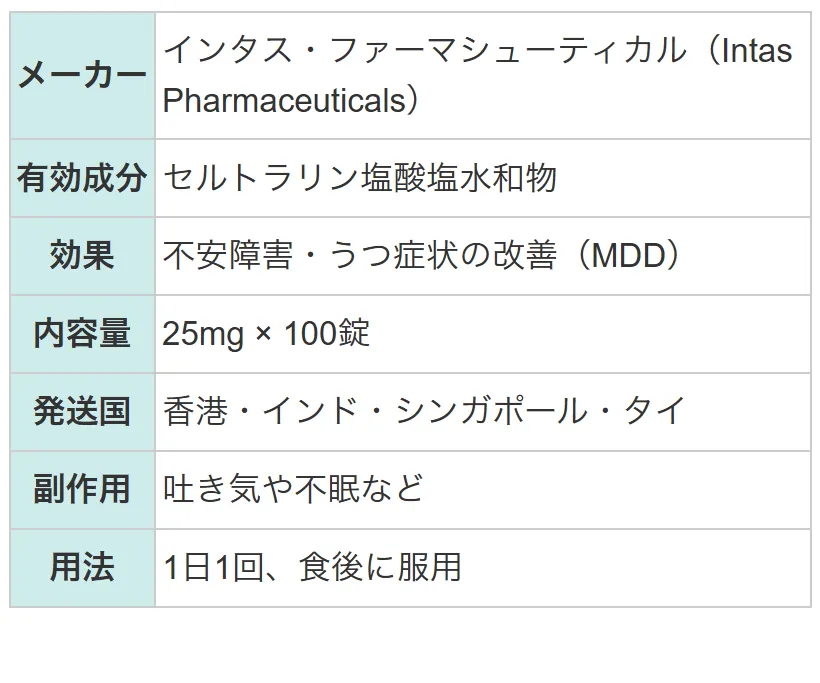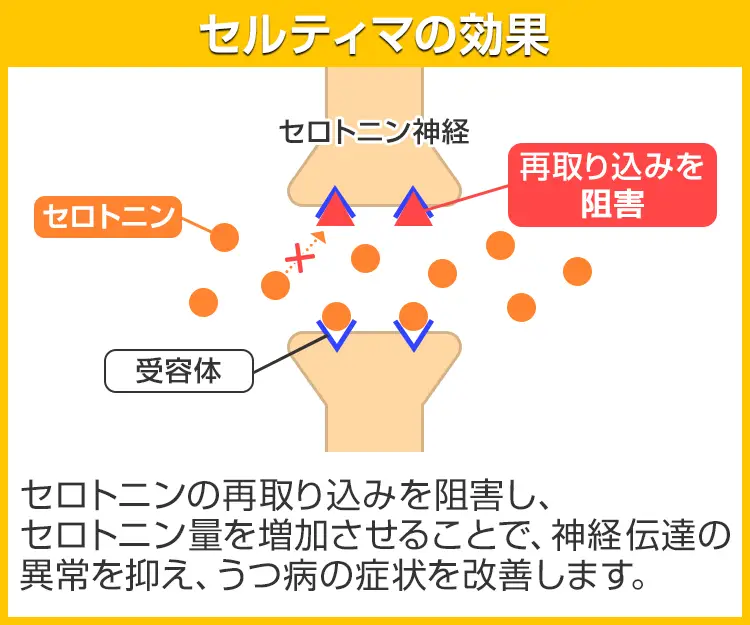処方されていたのと変わらない感じで気持ちが楽になります。ネットで人に会わずに購入できるので助かる。症状重い時に外出て人に会うとか無理。しかもこっちで買う方が安い。

左記クレジットカード、銀行振込、コンビニ決済に対応






更新日:2025/6/14
セルティマは、日本の心療内科クリニックで処方されることが多いジェイゾロフトと同一の成分を配合している抗うつ剤です。
ジェイゾロフトを服用している方はスムーズな切り替えが可能で、コストも抑えることができます。
| メーカー | インタス・ファーマシューティカル(Intas Pharmaceuticals) |
|---|---|
| 有効成分 | セルトラリン塩酸塩水和物 |
| 効果 | 不安障害・うつ症状の改善(MDD) |
| 副作用 | 吐き気や不眠など |
| 用法 | 1日1回、食後に服用 |
セルティマの有効成分は、精神状態を安定させる神経伝達物質セロトニンの濃度を高める作用があるセルトラリンです。セロトニンがいったん放出されたあと一部が神経終末に再取り込みされることを阻害し、効果を発揮します。
1錠あたり25mg、50mg、100mgを配合した3種類があります。

| 個数 | 販売価格(1錠あたり) | 販売価格(箱) | ポイント | 購入 |
|---|---|---|---|---|
| 100錠 | 54円 | 5,460円 | 163pt |
| 個数 | 販売価格(1錠あたり) | 販売価格(箱) | ポイント | 購入 |
|---|---|---|---|---|
| 100錠 | 74円 | 7,460円 | 223pt |
| 個数 | 販売価格(1錠あたり) | 販売価格(箱) | ポイント | 購入 |
|---|---|---|---|---|
| 100錠 | 80円 | 8,060円 | 241pt |






①1万円以上で送料無料
1回の注文で10,000円以上だった場合、1,000円の送料が無料となります。
まとめ買いをすると1商品あたりのコストパフォーマンスが高くなるためおすすめです。
②プライバシー守る安心梱包
外箱に当サイト名や商品名が記載されることはないため、ご家族や配達員など第三者に内容を知られることは御座いません。

③100%メーカー正規品取り扱い
当サイトの商品は100%メーカー正規品となっており、第三者機関による鑑定も行っております。
商品の破損などがあった場合は再配送などにて対応させて頂きますので、ご連絡頂ければ幸いです。

④いつでも購入可能 処方箋不要
サイト上では24時間いつでもご注文を受けております。
また、お電話によるご注文も受け付けておりますのでネットが苦手な方はお気軽にどうぞ。

⑤商品到着100%
商品発送後はお荷物の追跡状況が分かる追跡番号をご案内させて頂きます。
郵便局には保管期限がありますのでご注意ください。
・自宅配達で不在だった場合の保管期限・・・16日間前後
・郵便局留めとした場合の保管期限・・・7~30日間

⑥コンビニ決済利用可能
ご近所のコンビニにていつでもお支払可能です。
セブンイレブンに限り店舗での機械操作を必要とせず、手続き完了後に表示されるバーコードや払込票番号をレジに提示することでお支払い頂けます。

セルティマ 25mg x 100錠
5,460円
ポイント:163pt
10,000円以上購入で送料無料
在庫あり

処方されていたのと変わらない感じで気持ちが楽になります。ネットで人に会わずに購入できるので助かる。症状重い時に外出て人に会うとか無理。しかもこっちで買う方が安い。
寝る前に飲んでたけど翌日になると頭痛がする。不安定だった気持ちが安定するようにはなったから効き目はよかった。飲み続けるなら副作用を感じたくないから今は違う薬にしてる。
うつ病治療薬の中には、適切な用法用量を守らず使用した場合には、依存してしまう可能性があるものもあります。適切に服用しなかった場合には副作用のリスクも高まってしまいます。薬を服用することで効果的にうつの改善を目指せるため、適切な用法用量を守ってご使用ください。
薬の服用で副作用が強くあらわれるといったような場合、継続して服用すれば副作用症状が緩和していくといったこともあります。ですが、あまりにも合わないといったような場合には、医師と相談しながら減薬などを進めていくといった必要があります。
薬を服用することによって、うつ病による不安などの症状を緩和することができます。その上で、適切なカウンセリングなどを受けることでうつ病を根本的に改善へと導けるようになります。
うつ病の薬の作用に生理が来なくなるといったものはありません。しかし、うつ病によるストレスや食欲の低下などがホルモンバランスに影響して生理が遅れたり、止まったりする可能性があります。
うつ病治療薬の中止や休薬は計画的に行う必要があります。そのため、無計画に休薬などをしてしまった場合、パニックなどの離脱症状があらわれる可能性があります。そのため、薬の服用を中止する場合には、事前に医師に相談するようにしてください。
| 1日の服用回数 | 1回 |
|---|---|
| 1日の服用量 | 25~100mg |
| 服用のタイミング | 指定なし |
| 服用間隔 | 24時間 |
| 商品名 | アナフラニール | トフラニール | フルニル | ジェリフォルテ | パキシル・ジェネリック | ティアプレックス | プロザック |
|---|---|---|---|---|---|---|---|
| 商品画像 |  |  |  |  |  |  |  |
| 特徴1 | ・昔から国内で処方されている抗うつ剤 | ・他の治療薬では効果がなかった方にも有効 | 世界が認めた抗うつ成分を配合 | ・免疫力の低下を防ぐ効果にも期待できる | ・症状に応じて4種類から選べる | ・さまざまな精神症状に応用されている有効成分を配合 | 有効成分が「幸せホルモン」濃度を高める |
| 特徴2 | ・軽度の副作用はあるものの高い効果を持つ | ・世界中で処方されている抗うつ剤 | 有効成分はパニック障害にも有用とされる | ・天然成分が精神的な負担を軽減する | ・パキシルのジェネリックで安価 | ・病院で処方されているグラマリール錠と同成分 | 大手メーカー製造の安全な抗うつ剤 |
| 内容量 | 10mg30錠x1箱 | 25mgx50錠 | 10mgx100錠 | 100錠 | 10mgx100錠 | 25mg100錠x1箱 | 20mg28錠x1箱 |
| 価格 | 4,460円 | 4,160円 | 3,560円 | 2,860円 | 9,460円 | 4,160円 | 5,360円 |
| 1%以上 | 1%未満 | 頻度不明 | |
| 精神系 | 睡眠障害(不眠等)、錯乱状態 | 悪夢、易刺激性、易興奮性、うつ病、躁病、精神症、多幸症、リビドー減退、記憶障害、注意力障害 | 攻撃的反応、不安、焦燥、興奮、幻覚 |
| 神経系 | 傾眠(15.2%)、頭痛、浮動性めまい、振戦、感覚減退 | 起立性めまい、味覚異常、頭部不快感、運動障害(アカシジア、錐体外路症状、運動過多、歯ぎしり、歩行異常等)、錯感覚 | 不随意性筋収縮、ジスキネジー、ジストニー、片頭痛、失神 |
| 感覚器 | 調節障害、視覚異常(霧視、羞明、視力低下等)、耳鳴、耳閉感、回転性眩暈 | 散瞳 | |
| 循環器 | 動悸 | 起立性低血圧、血圧低下、血圧上昇、頻脈 | |
| 肝臓 | ALT増加、AST増加、γ-GTP増加 | LDH増加、Al-P増加、総ビリルビン増加、直接ビリルビン増加 | |
| 血液 | 白血球数増加又は減少、単球増加、出血傾向(鼻出血、胃腸出血、血尿等) | 血小板機能異常、紫斑、斑状出血、皮下出血 | |
| 消化器系 | 悪心・嘔吐(20.3%)、口内乾燥、下痢・軟便、便秘、腹部不快感、腹痛、腹部膨満、消化不良、食欲不振 | 胃腸障害、食欲亢進 | 膵炎 |
| 過敏症 | 発疹 | 蕁麻疹、そう痒症、顔面浮腫、眼窩周囲浮腫 | 光線過敏性反応 |
| 泌尿器・生殖器 | 排尿困難、尿閉、頻尿、性機能障害(射精遅延、持続勃起症等)、月経障害 | 尿失禁・夜尿、乳汁漏出症、女性化乳房 | |
| 筋・骨格系 | 背部痛、関節痛、筋緊張異常(筋硬直、筋緊張亢進、筋痙攣等) | 開口障害 | |
| 代謝・内分泌 | 総蛋白減少、総コレステロール増加、尿糖、尿蛋白 | 甲状腺機能低下症、低ナトリウム血症、高プロラクチン血症、血糖異常 | |
| その他 | 倦怠感、多汗(発汗、寝汗等) | 無力症、熱感、異常感、胸痛、胸部圧迫感、疲労、発熱、ほてり、悪寒、体重減少、体重増加、末梢性浮腫、あくび、脱毛症 | 気管支痙攣、好酸球性肺炎 |
本製品は海外製のため、期限表記が日本と異なる場合がございます。
パッケージ裏面や側面、シートなどに以下のような表記がされています。
| EXP | 使用期限 例:EXP 12/2025→2025年12月まで使用可 |
|---|---|
| MFG または MFD | 製造日 例:MFG 03/2023 |
| BEST BEFORE | 品質が最も安定している目安日 |


※国や製品により日付の並び(例:月/年、日/月/年)が異なる場合がありますのでご注意ください
EXP(Expiry Date) の表記がなく、MFG または MFDしか記載がないケースがあります。
この場合は MFG(MFD) から2~3年が使用期限の目安です。
※「LOT」や「BATCH」の表記は製造番号であり期限ではありません。

パッケージ例となります。
商品やご注文単位によってはシート単位でのお届けとなる場合が御座います。
外箱に当サイト名や商品名が記載されることはないため、ご家族や配達員など第三者に内容を知られることは御座いません。
何をするにも億劫で、好きなことさえ楽しめなくなっていました。これを飲み続けているうちに、少しずつ「やってみようかな」という気持ちが生まれるように。小さなことからですが、活動範囲が広がっています。
発作は減ったけど、服用中は常に眠気との戦い…。特に午前中は集中するのが大変。あと、たまに下痢をすることも。発作の恐怖よりはマシだけど、副作用がもう少し軽ければ。
突然の動悸や息苦しさに襲われるのが怖くて、電車にも乗れませんでした。このお薬を続けていたら、発作の回数が減り、予期不安も和らぎました。
処方されていたのと変わらない感じで気持ちが楽になります。ネットで人に会わずに購入できるので助かる。症状重い時に外出て人に会うとか無理。しかもこっちで買う方が安い。
結構効きます、頭のモヤモヤがクリアになりました、副作用的なのも今のとこないです、この調子で良くなっていければと思います、効くのがわかったので、今は25ですが次から50の方にします、これからもよろしくお願いします、
商品口コミの投稿は会員のみ行えるようになっております。
お手数ですが会員ログインの上でご投稿頂きますようお願いいたします。
口コミをご投稿頂いたお客様にはポイントをプレゼントさせて頂いております。
文章のみであれば100ポイント、文章+写真付きのものは300ポイントをプレゼントさせて頂きます。
規約や詳細などはこちらをご確認くださいませ。